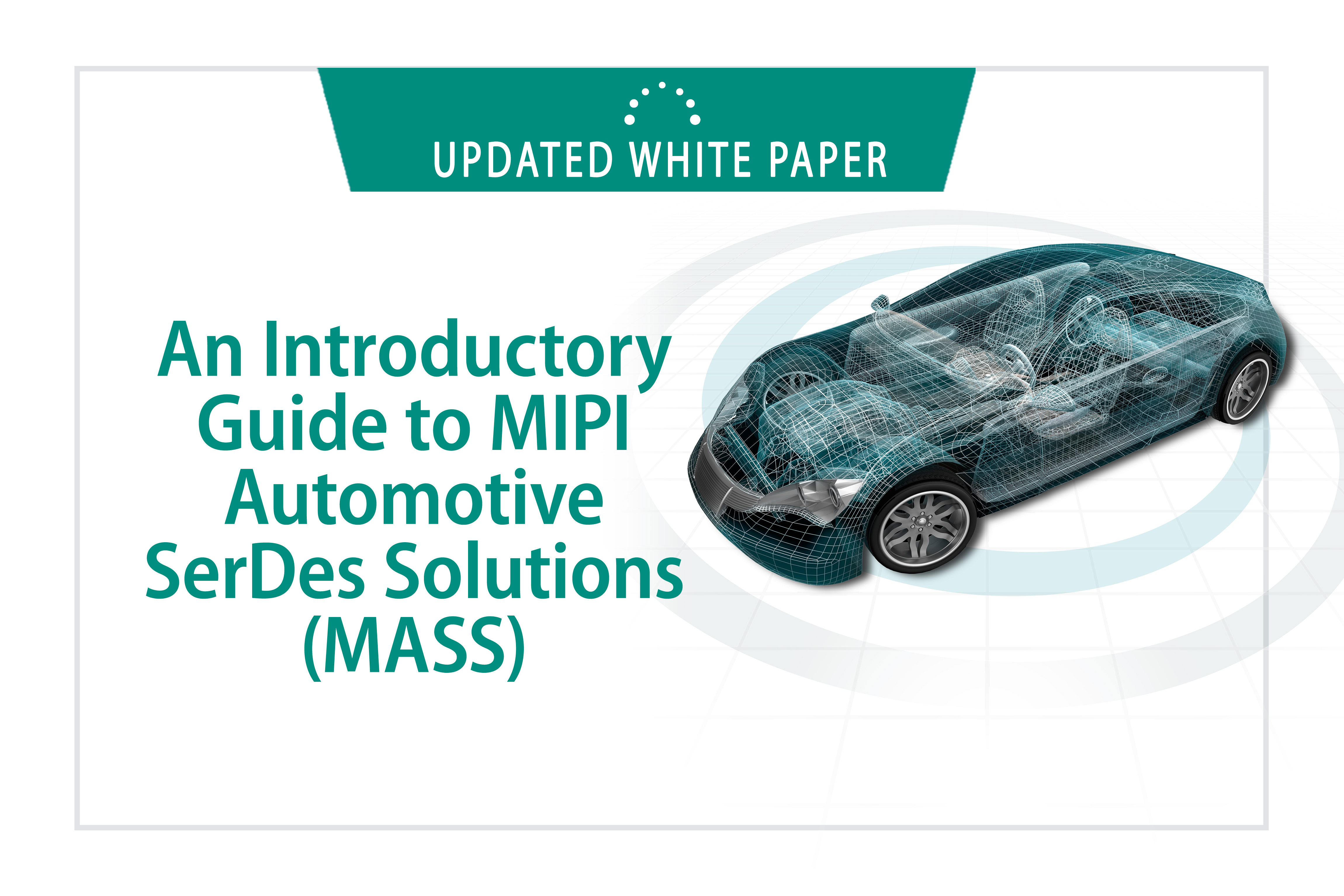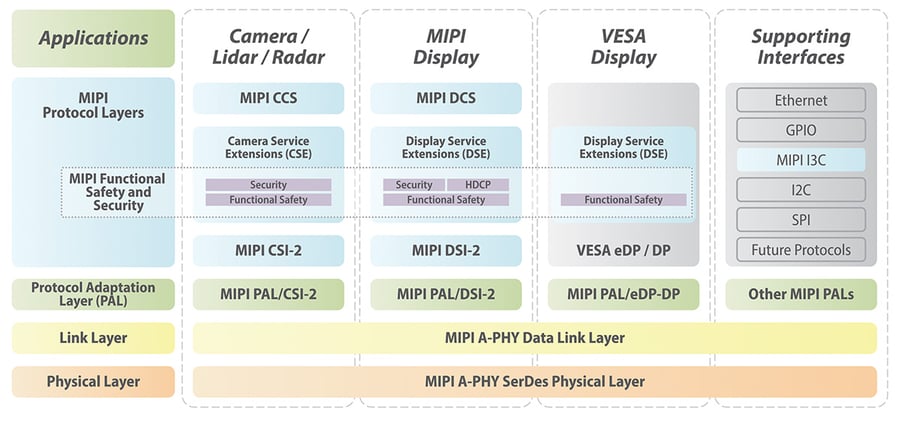4 min read
White Paper Refresh: Introductory Guide to MIPI Automotive SerDes Solutions
![]() Ian Smith, MIPI Alliance Technical Content Consultant
:
21 September 2023
Ian Smith, MIPI Alliance Technical Content Consultant
:
21 September 2023

- News & Events
- News
- Blog
First published in August 2021, the MIPI white paper, "An Introductory Guide to MIPI Automotive SerDes Solutions (MASS℠)" provides an overview of MIPI’s standardized automotive connectivity framework for high‑performance sensors and displays, and explains how MASS addresses the in-vehicle connectivity requirements of future automotive sensor (camera/lidar/radar) and display systems.
The paper has now been updated to reflect the most recent developments to MASS specifications, to ensure the framework addresses the latest and most advanced automotive use cases.
In addition to outlining the current specifications that make up the MASS framework, it also includes serveral key updates:
- An overview of how the forthcoming MIPI security framework can be applied to MASS, with specific focus on how the new security functionality, slated for delivery in the forthcoming MIPI Camera Service Extensions (CSE℠), Display Service Extensions (DSE℠) and new Command and Control Interface Service Extensions (CCISE℠) specifications, will provide application-level "end-to-end" data protection regardless of the underlying network topology
- A preview of future MIPI A-PHY® developments, including A-PHY v2.0, which will add new speed gears that double the peak downlink throughput over a single cable to 32 Gbps and increase the peak uplink throughput to 1.6 Gbps; and the MIPI Power Over A-PHY (PoA) specification, which will add new power classes to address new voltage requirements in the automotive industry, including the need to support 48-volt operation
- New example use case showing how MASS enables daisy-chaining of multiple high-resolution automotive displays, reducing the complexity and weight of cable harnesses and simplifying the connection of the displays during vehicle manufacturing
Building Upon the Original Paper
These updates add to the core of the original paper to provide a comprehensive overview of all MASS components, describing how MASS provides an end-to-end, full stack connectivity framework that leverages MIPI A-PHY, MIPI CSI‑2®, MIPI DSI‑2℠ and many other de facto industry standardized protocols and offers built-in functional safety, security and resilience.
The white paper provides a detailed overview of four principal components:
- Physical layer: The foundation of MASS is A-PHY, the first industry-standard long-reach (up to 15m) asymmetric SerDes physical layer interface providing high performance (up to 3264 Gbps in v1.1v2.0), high EMI immunity and near-zero latency. A-PHY is designed specifically to meet the needs of the automotive industry and will eliminate the need for proprietary PHYs and bridges, simplifying in-vehicle communication networks and reducing cost, weight and development time. A-PHY provides a protocol-agnostic data link layer to enable support for MIPI and other approved third-party higher layer protocols. It supports multiple cable types including coax, SPP/STP and STQ. It also supports power over cable with multiple power classes.
- Higher-layer protocols: The framework incorporates a suite of widely adopted higher layer application protocols used in billions of devices and already widely adopted in automotive applications. These protocols include MIPI CSI-2 for cameras, MIPI DSI-2 and VESA eDP/DP for displays, and lower speed protocols such as I2C (Inter-Integrated Circuit), GPIO (General Purpose Input Output), Ethernet, SPI (Serial Peripheral Interface) and the emerging MIPI I3C® protocol. Use of these widely adopted protocols will drive economies of scale, reduce development costs and provide backward and forward compatibility.
- Functional safety: Several functional safety enabling features are built into the framework, helping MASS-based applications meet the functional safety requirements of ISO standard 26262:2018 "Road vehicles – Functional safety" and enabling designers to build systems that meet common Automotive Safety Integrity Level (ASIL) specifications from ASIL B through ASIL D.
- Security: MASS incorporates the MIPI Security Framework, a suite of specifications that enable key security functionality, including authentication of system components, data integrity protection and data encryption. The security framework is uniquely effective in both its security extent and implementation flexibility. MASS also supports High-bandwidth Digital Content Protection (HDCP) for display applications.
The paper explains how these components are implemented into the MASS protocol stack, describing in detail each component shown in the image below:
Caption: The MASS Protocol Stack (Source: MIPI Alliance)
One key layer of the stack is the MIPI A-PHY Protocol Adaptation Layer (PAL℠), which defines the adaptations necessary to carry proven MIPI and approved third-party protocols over A-PHY links. The PAL maps those approved higher-layer protocols to A-PHY’s A-Packet format, acting as a conduit to and from A-PHY’s generic data link layer. In this way, the PAL enables higher-layer protocols to operate seamlessly over A-PHY physical links.
Benefits of MASS
In addition to its technical focus, the paper also outlines the commercial benefits of adopting the standardized MASS framework:
- Creates economies of scale around a set of industry-supported standards, reducing integration costs and enabling automotive original equipment manufacturers (OEMs) and Tier 1 suppliers to amortize engineering costs over larger volumes of components
- Helps the industry improve technologies faster, as vendors develop more efficient ways to implement these specifications, which will then be integrated into future releases
- Eases ongoing product maintenance and updates, thanks to backward and forward compatibility, while also encouraging long-term developer support
- Removes the burden of designing or selecting a proprietary interface, allowing OEMs and Tier 1 suppliers to focus on "higher value" product differentiating technologies in the protocol stack–such as applications that leverage machine learning and artificial intelligence to provide enhanced customer experiences
- Has been purpose-built to address applications that require high-speed, highly asymmetric data links within a vehicle
- Complements symmetric protocols such as automotive Ethernet. While Ethernet and other symmetric network protocols are primarily designed for full duplex, symmetric networking among peer devices, MASS is optimized to link resource-constrained peripheral components with their associated electronic control units
- Enables components at the edge of a vehicle to be smaller and less complex while providing high bandwidth in one direction, such as an inbound data stream from a camera or lidar sensor to an ECU, or an outbound data stream from an ECU to a digital cockpit display
Roughly half of MIPI Alliance’s nearly 400 member companies are active in the automotive sector. MIPI invites the input of OEMs and Tier 1 suppliers to ensure that all MASS specifications and supporting resources meet the requirements of the automotive industry.
For information about MIPI membership and how to participate in working groups, visit the Join MIPI page.








